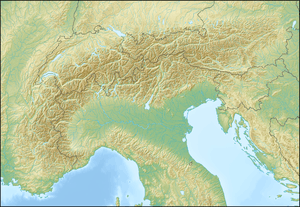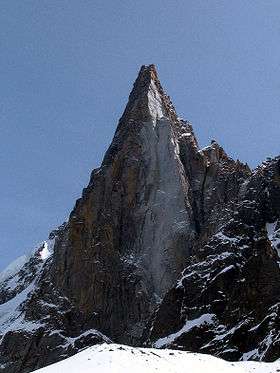Dent du Géant
| Dent du Géant | |
|---|---|
 The sharp pinnacle of the Dent du Géant (left) at the western end of the Rochefort ridge (centre) | |
| Highest point | |
| Elevation | 4,013 m (13,166 ft) |
| Prominence | 139 m (456 ft) [1] |
| Isolation | 1.2 kilometres (0.75 mi) |
| Coordinates | 45°51′43″N 6°57′6″E / 45.86194°N 6.95167°ECoordinates: 45°51′43″N 6°57′6″E / 45.86194°N 6.95167°E |
| Geography | |
 Dent du Géant | |
| Parent range | Graian Alps |
| Climbing | |
| First ascent | 20 August 1882 by William Woodman Graham with guides Auguste Cupelin and Alphonse Payot |
| Easiest route | South-west face (AD) |
The Dent du Géant (It.: Dente del Gigante, "giant's tooth") (4,013 m) is a mountain in the Mont Blanc massif in France and Italy.
The Dent du Géant remained unclimbed during the golden age of alpinism, and was a much-coveted peak in the 1870s, repelling many parties who attempted it mostly from the Rochefort ridge. In 1880 the strong team of Albert F. Mummery and Alexander Burgener tried to force a passage via the south-west face but were repelled by a band of slabs, causing Mummery to exclaim 'Absolutely inaccessible by fair means!'[2]
The mountain has two summits, 88 feet (27 m) apart and separated by a small col (an 'extremely awkward notch' according to W. W. Graham):[3]
- Pointe Sella (4,009 m), first ascent via the south-west face by Jean Joseph Maquignaz with son Baptiste Maquignaz and nephew, Daniel Maquignaz on 28 July 1882. Over a period of four days they placed iron stanchions and fixed ropes,[4] enabling the same party to climb Pointe Sella a second time on the following day with clients Alessandro Sella, Alfonso Sella, Corradino Sella and Gaudenzio Sella.
- Pointe Graham (4,013 m), first ascent by W. W. Graham with guides Auguste Cupelin and Alphonse Payot on 20 August 1882. They used the fixed ropes of "Sella's staircase" to repeat the ascent of Pointe Sella, where Graham noted that one of the Maquignazes had carved the letter 'M' on a rock step. They then lowered themselves 12 metres (39 ft) into the col to climb this higher north-east peak.[4]
This ascent marked the end of the so-called silver age of alpinism.

On 28 July 1935 the Austrian climbers Herbert Burggasser and Rudi Leitz first ascended the vertical-to-overhanging 160 m-high south face. It was the first climb in the Western Alps systematically aided by the pitons and artificial techniques that were already in use by climbers in the Eastern Alps.[5]
The following huts serve the mountain:
- Rifugio Torino (3,372 m, CAI, staffed mid May–end September)
- Torino hut (3,332 m, CAI, all year)
- Pointe Hellbronner (3,462 m, téléphérique station which can be used as a base)
References
- ↑ Mountains above 4000 meter in the Alps
- ↑ Quoted in Dumler, Helmut and Willi P. Burkhardt, The High Mountains of the Alps, London: Diadem, 1994, p. 179
- ↑ Graham, W. W., 'The Dent du Géant', Alpine Journal XI; reprinted in Peaks, Passes and Glaciers, ed. W. Unsworth, London: Allen Lane, 1981, pp. 73–7. Graham gives the date of his first attempt as 14 August and of his successful ascent as 20 August; Dumler curiously gives 14 August as the date of the first ascent.
- 1 2 Willy Blaser and Glyn Hughes, Kabru 1883, a reassessment, The Alpine Journal 2009, p. 209
- ↑ Lindsay Griffin, Huber free solos south face of the Géant, alpinsyt.com, October 5, 2006
External links
| Wikimedia Commons has media related to Dent du Géant. |


